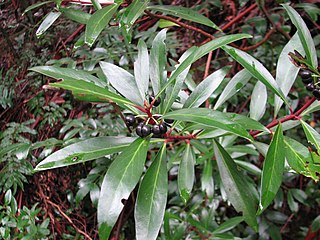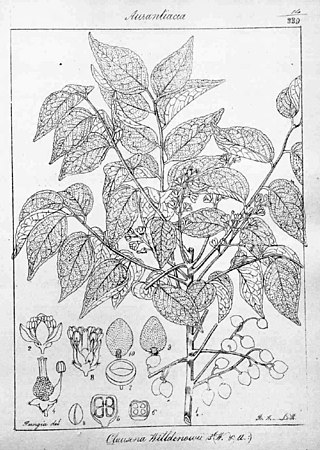
The bay leaf is an aromatic leaf commonly used as a herb in cooking. It can be used whole, either dried or fresh, in which case it is removed from the dish before consumption, or less commonly used in ground form. The flavor that a bay leaf imparts to a dish has not been universally agreed upon, but most agree it is a subtle addition.

Cloves are the aromatic flower buds of a tree in the family Myrtaceae, Syzygium aromaticum. They are native to the Maluku Islands in Indonesia, and are commonly used as a spice, flavoring, or fragrance in consumer products, such as toothpaste, soaps, or cosmetics. Cloves are available throughout the year owing to different harvest seasons across various countries.

An essential oil is a concentrated hydrophobic liquid containing volatile chemical compounds from plants. Essential oils are also known as volatile oils, ethereal oils, aetheroleum, or simply as the oil of the plant from which they were extracted, such as oil of clove. An essential oil is essential in the sense that it contains the essence of the plant's fragrance—the characteristic fragrance of the plant from which it is derived. The term "essential" used here does not mean indispensable or usable by the human body, as with the terms essential amino acid or essential fatty acid, which are so called because they are nutritionally required by a living organism.

Basil, also called great basil, is a culinary herb of the family Lamiaceae (mints). It is a tender plant, and is used in cuisines worldwide. In Western cuisine, the generic term "basil" refers to the variety also known as sweet basil or Genovese basil. Basil is native to tropical regions from Central Africa to Southeast Asia. In temperate climates basil is treated as an annual plant, however, basil can be grown as a short-lived perennial or biennial in warmer horticultural zones with tropical or Mediterranean climates.

Backhousia citriodora is a flowering plant in the family Myrtaceae, genus Backhousia. It is endemic to subtropical rainforests of central and south-eastern Queensland, Australia, with a natural distribution from Mackay to Brisbane. Other common names are sweet verbena tree, sweet verbena myrtle,, and lemon scented backhousia.

Backhousia is a genus of thirteen currently known species of flowering plants in the family Myrtaceae. All the currently known species are endemic to Australia in the rainforests and seasonally dry forests of Queensland, New South Wales and Western Australia.

Tasmannia lanceolata, commonly known as Tasmanian pepperberry or mountain pepper, is a shrub native to woodlands and cool temperate rainforest of south-eastern Australia. The shrub varies from 2–10 metres (6.6–32.8 ft) high. The aromatic leaves are lanceolate to narrow-elliptic or oblanceolate, 4–12 cm long, and 0.7–2.0 cm wide, with a distinctly pale undersurface. Stems are quite red in colour. The small cream or white flowers appear in summer and are followed by black, globose, two-lobed berries 5–8 mm wide, which appear in autumn. There are separate male and female plants.

Syzygium anisatum, with common names ringwood and aniseed tree, is a rare Australian rainforest tree with an aromatic leaf that has an essential oil profile comparable to true aniseed.

Alternaria alternata is a fungus causing leaf spots, rots, and blights on many plant parts, and other diseases. It is an opportunistic pathogen on over 380 host species of plant.
Alternaria helianthi is a fungal plant pathogen causing a disease in sunflowers known as Alternaria blight of sunflower.

Backhousia leptopetala is a common Australian tree, growing from Stanwell Park in the northern Illawarra district to near Buderim in south eastern Queensland.

Austropuccinia psidii, commonly known as myrtle rust, guava rust, or ʻōhiʻa rust; is a rust native to South America that affects plants in the family Myrtaceae. It is a member of the fungal complex called the guava rust group. The spores have a distinctive yellow to orange colour, occasionally encircled by a purple ring. They are found on lesions on new growth including shoots, leaves, buds and fruits. Leaves become twisted and may die. Infections in highly susceptible species may result in the death of the host plant.

Polygala myrtifolia, the myrtle-leaf milkwort, is an evergreen 2-4m tall South African shrub or small tree found along the southern and south-eastern coasts, from near Clanwilliam in the Western Cape to KwaZulu-Natal. It is a fast-growing pioneer plant, a typical fynbos component, and may be found on dunes, rocky places, along forest margins, beside streams, and in open grassland. It belongs to the milkwort family of Polygalaceae.

Clausena anisata (Willd.) Hook.f. ex Benth. is a deciduous shrub or small tree, belonging to the Rutaceae or Citrus family, and widespread in the Afrotropical realm or Sub-Saharan Africa, but absent from the drier regions. It is also found in tropical and South-East Asia, growing in India and Sri Lanka and extending as far as Queensland in north-eastern Australia and some Pacific islands. It is cultivated in Malaysia and Indonesia. As with other plants useful to mankind its large range of medicinal properties has led to a global distribution and its growth wherever the climate is suitable. It grows in higher-rainfall regions in savanna, thickets, riverine forest, disturbed areas and secondary forest, up to an altitude of 3000 m. The leaves, which are foetid when bruised, give rise to the common name 'Horsewood' or the more descriptive Afrikaans common name 'Perdepis', meaning 'horse urine'.
Alternaria black spot of canola or grey leaf spot is an ascomycete fungal disease caused by a group of pathogens including: Alternaria brassicae, A. alternata and A. raphani. This pathogen is characterized by dark, sunken lesions of various size on all parts of the plant, including the leaves, stem, and pods. Its primary economic host is canola. In its early stages it only affects the plants slightly by reducing photosynthesis, however as the plant matures it can cause damage to the seeds and more, reducing oil yield as well.

Melaleuca bracteata, commonly known as the black tea-tree, river tea-tree or mock olive is a plant in the myrtle family, Myrtaceae and is endemic to northern Australia. It usually occurs as a large shrub but under ideal conditions can grow into a tree up to 10 m (30 ft) tall. It is an adaptable species in cultivation and a number of cultivars have been developed.

Greek basil is a flowering herb and cultivar of basil.

Pseuduvaria glabrescens is a species of plant in the family Annonaceae. It is native to Australia. L.W. Jessup, the botanist who first formally described the species using the synonym Pseuduvaria mulgraveana var. glabrescens, named it after the underside of its leaves which have the quality of becoming hairless as they mature.
















